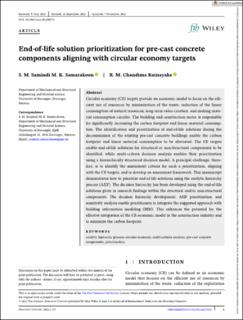| dc.contributor.author | Samarakoon, Mudiyansele Samindi Manjula K | |
| dc.contributor.author | RATNAYAKE MUDIYANSELAGE, Chandima | |
| dc.date.accessioned | 2023-01-03T06:50:21Z | |
| dc.date.available | 2023-01-03T06:50:21Z | |
| dc.date.created | 2022-11-22T09:14:36Z | |
| dc.date.issued | 2022 | |
| dc.identifier.citation | Samarakoon, S. S. M., & Ratnayake, R. C. (2022). End‐of‐life solution prioritization for pre‐cast concrete components aligning with circular economy targets. Structural Concrete. | en_US |
| dc.identifier.issn | 1464-4177 | |
| dc.identifier.uri | https://hdl.handle.net/11250/3040414 | |
| dc.description.abstract | Circular economy (CE) targets provide an economic model to focus on the efficient use of resources by minimization of the waste, reduction of the linear consumption of natural resources, long-term value creation, and making material consumption circular. The building and construction sector is responsible for significantly increasing the carbon footprint and linear material consumption. The identification and prioritization of end-of-life solutions during the decommission of the existing pre-cast concrete buildings enable the carbon footprint and linear material consumption to be alleviated. The CE targets enable end-of-life solutions for structural or non/structural components to be identified, while multi-criteria decision analysis enables their prioritization using a hierarchically structured decision model. A principal challenge, therefore, is to identify the assessment criteria for such a prioritization, aligning with the CE targets, and to develop an assessment framework. This manuscript demonstrates how to prioritize end-of-life solutions using the analytic hierarchy process (AHP). The decision hierarchy has been developed using the end-of-life solutions given in research findings within the structural and/or non-structural components. The decision hierarchy development, AHP prioritization, and sensitivity analysis enable practitioners to integrate the suggested approach with building information modeling (BIM). This enhances the potential for the effective integration of the CE economic model in the construction industry and to minimize the carbon footprint. | en_US |
| dc.language.iso | eng | en_US |
| dc.publisher | Wiley | en_US |
| dc.rights | Navngivelse 4.0 Internasjonal | * |
| dc.rights.uri | http://creativecommons.org/licenses/by/4.0/deed.no | * |
| dc.title | End-of-life solution prioritization for pre-cast concrete components aligning with circular economy targets | en_US |
| dc.title.alternative | End-of-life solution prioritization for pre-cast concrete components aligning with circular economy targets | en_US |
| dc.type | Peer reviewed | en_US |
| dc.type | Journal article | en_US |
| dc.description.version | publishedVersion | en_US |
| dc.rights.holder | The author | en_US |
| dc.subject.nsi | VDP::Matematikk og Naturvitenskap: 400 | en_US |
| dc.source.journal | Structural Concrete | en_US |
| dc.identifier.doi | 10.1002/suco.202200572 | |
| dc.identifier.cristin | 2077809 | |
| cristin.ispublished | true | |
| cristin.fulltext | original | |
| cristin.qualitycode | 1 | |

